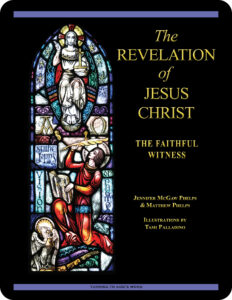 The Revelation of Jesus Christ:
The Revelation of Jesus Christ:
The Faithful Witness
Lesson 21 This Is the First Resurrection
the book of Revelation 20:1–15
Revised Standard Version Catholic Edition (RSVCE)*
New American Bible Revised Edition (NABRE)*
Catechism of the Catholic Church
Rosarium Virginis Mariae (Rosary of the Virgin Mary)
ex libris (in our library)
glossary for the book of Revelation
cross references in the book of Revelation
chapter-by-chapter review page
next lesson: I Saw a New Heaven & a New Earth
This material coordinates with Lesson 21 on pages 127–133 in The Revelation of Jesus Christ: The Faithful Witness.
“Great and wonderful are your deeds, O Lord God the Almighty! Just and true are your ways,
O King of the ages! Who shall not fear and glorify your name, O Lord? For you alone are holy.
All nations shall come and worship you, for your judgments have been revealed.”
—the book of Revelation 15:3–4
welcome to our in-depth study of the book of Revelation
We invite groups and individuals to check out the sample first lesson and video from this 23-lesson Turning to God’s Word Catholic Bible study. Our online pages link
link  to the free lesson videos, a glossary, cross references in the biblical text, and a chapter-by-chapter review page—and they also include illustrations, maps, additional commentary, and prayers based on the primary Scripture in each lesson. The Revelation of Jesus Christ: The Faithful Witness has been granted an imprimatur. The study may be purchased from our website shop. If you have a Bible-related question or comment, click on the “ask us your question” or “what do you think” button on any study page.
to the free lesson videos, a glossary, cross references in the biblical text, and a chapter-by-chapter review page—and they also include illustrations, maps, additional commentary, and prayers based on the primary Scripture in each lesson. The Revelation of Jesus Christ: The Faithful Witness has been granted an imprimatur. The study may be purchased from our website shop. If you have a Bible-related question or comment, click on the “ask us your question” or “what do you think” button on any study page.
open with prayer
It’s always wise to begin any Bible study with prayer, whether reading the Scriptures alone or meeting with others in a discussion study group. You can pray using your own words or use one of the opening prayers on our website. We especially like the following:
Lord Jesus, you promised to send your Holy Spirit
to teach us all things.
As we read and study your word today,
allow it to touch our hearts and change our lives. Amen.
let’s review—the book of Revelation 19:1–21
Lesson 20 The Mighty Voice of a Great Multitude describes a great multitude in heaven crying “Hallelujah,” a type of praise associated with major Jewish liturgical festivals. A voice from the throne announces that the marriage of the Lamb has come. The author is told to write that those who are invited to the marriage supper of the Lamb are blessed. Heaven is opened and a rider appears on a white horse; he is called by the name “The Word of God.” Instead of going to his wedding however, he appears to be riding out to do battle. After much buildup, this battle with evil is anticlimactic: “The Word of God” easily defeats his enemies. The beast and the false prophet are thrown alive into the lake of fire. Their followers are slain by the sword that issues from the mouth of “The Word of God.”
danger—proceed with caution
There are many strange images in the book of Revelation, but none so wild as some of the
interpretations that have been suggested to explain what’s going on in this section. Forming a hasty 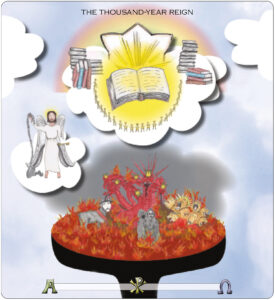 opinion at this juncture easily could fly in the face of Church teaching, but in order to avoid doing that it’s
opinion at this juncture easily could fly in the face of Church teaching, but in order to avoid doing that it’s 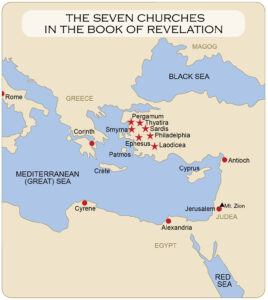 necessary to have an understanding of what the Church actually teaches. Because the last things aren’t a common topic of homilies, many Catholics are confused when they encounter such terms as “first resurrection” and “second death.” The best place to turn for solid information is the Catechism of the Catholic Church, which includes teaching devoted to the profession of the Creed: “I believe in life everlasting.” Th section encompassing paragraphs 1020
necessary to have an understanding of what the Church actually teaches. Because the last things aren’t a common topic of homilies, many Catholics are confused when they encounter such terms as “first resurrection” and “second death.” The best place to turn for solid information is the Catechism of the Catholic Church, which includes teaching devoted to the profession of the Creed: “I believe in life everlasting.” Th section encompassing paragraphs 1020 
 through 1060 in the Catechism covers such things as the particular judgment, heaven, purgatory, hell, the last judgment, and the hope of the new heaven and the new earth. Anyone uncertain about exactly what the Church teaches regarding these last things would be wise to read over this section of the Catechism in conjunction with the twentieth chapter of the book of Revelation. Click on the image (above right) to enlarge Turning to God’s Word co-founder Tami Palladino’s illustration, which is on page 129 of The Revelation of Jesus Christ: The Faithful Witness. The map locating the seven churches that receive dictated letters from Jesus appears on page 131 and elsewhere in the study book; the image of the map can be enlarged by clicking on it.
through 1060 in the Catechism covers such things as the particular judgment, heaven, purgatory, hell, the last judgment, and the hope of the new heaven and the new earth. Anyone uncertain about exactly what the Church teaches regarding these last things would be wise to read over this section of the Catechism in conjunction with the twentieth chapter of the book of Revelation. Click on the image (above right) to enlarge Turning to God’s Word co-founder Tami Palladino’s illustration, which is on page 129 of The Revelation of Jesus Christ: The Faithful Witness. The map locating the seven churches that receive dictated letters from Jesus appears on page 131 and elsewhere in the study book; the image of the map can be enlarged by clicking on it.
 God is cleaning house before he moves in (01:32:33)
God is cleaning house before he moves in (01:32:33)
In the twentieth chapter in the book of Revelation, we’ve finally started to transition  out of the seven sevens and into the fiftieth day—Pentecost. We’ve started some liturgical things that have indicated we’re at the end of the forty-ninth day, but we haven’t moved into the fiftieth. Before this can happen, the author has to tie up some loose ends. Anything incompatible with God the Father coming to earth has to be dealt with. These things include the devil and death, but also some temporal and spatial distinctions need to disappear as well. In the video for this lesson, Turning to God’s Word
out of the seven sevens and into the fiftieth day—Pentecost. We’ve started some liturgical things that have indicated we’re at the end of the forty-ninth day, but we haven’t moved into the fiftieth. Before this can happen, the author has to tie up some loose ends. Anything incompatible with God the Father coming to earth has to be dealt with. These things include the devil and death, but also some temporal and spatial distinctions need to disappear as well. In the video for this lesson, Turning to God’s Word  author Matthew Phelps cautions participants to put aside literal interpretations about the 1,000-year reign. Without the context of the earlier lessons, it might be possible to buy into some of these bizarre theories that attempt to impose human history on the book of Revelation. We aren’t looking for a specific 1,000-year period as “when,” and we aren’t constrained by thinking that this event has to occur on earth as “where.” In the book of Revelation we have five times and three spaces where we can expect this 1,000-year reign. Logic based on Old Testament prophecy limits how we look at what’s going to happen.
author Matthew Phelps cautions participants to put aside literal interpretations about the 1,000-year reign. Without the context of the earlier lessons, it might be possible to buy into some of these bizarre theories that attempt to impose human history on the book of Revelation. We aren’t looking for a specific 1,000-year period as “when,” and we aren’t constrained by thinking that this event has to occur on earth as “where.” In the book of Revelation we have five times and three spaces where we can expect this 1,000-year reign. Logic based on Old Testament prophecy limits how we look at what’s going to happen.
The Scripture ranges for the videos that accompany this Catholic Bible study match the Scripture ranges for the sets of questions in The Revelation of Jesus Christ: The Faithful Witness. You can follow along with the video overview as Turning to God’s Word author Matthew Phelps discusses Lesson 21, “This Is the First Resurrection,” on pages 127–133 in the study book.
what’s the point for Christians today?
Unless you’re pursuing a degree as a Doctor of Sacred Theology in biblical studies (which, amusingly enough, the Church refers to as an S.T.D.), the best reason to read and study Scripture is to learn what God is telling us about how to live our lives. The application aspect of Scripture study can be difficult to locate in the book of Revelation, which doesn’t follow a consecutive narrative and which includes a number of easily misunderstood images. Turning to God’s Word Catholic Bible studies offer a number of suggestions for application. You regularly can find help in two places—Turning to God’s Word author Matthew Phelps  presents videos with each lesson, which you can access for free on these online study pages on our website, and the introduction to each lesson in the study book poses application questions. The introduction to Lesson 21 in The Revelation of Jesus Christ: The Faithful Witness, is reprinted here. The second paragraph is particularly helpful when trying to sort what this final book of the New Testament is saying to us. The same approach to looking at spiritual incidents in our own lives frequently can shed light on other passages in the Bible as well.
presents videos with each lesson, which you can access for free on these online study pages on our website, and the introduction to each lesson in the study book poses application questions. The introduction to Lesson 21 in The Revelation of Jesus Christ: The Faithful Witness, is reprinted here. The second paragraph is particularly helpful when trying to sort what this final book of the New Testament is saying to us. The same approach to looking at spiritual incidents in our own lives frequently can shed light on other passages in the Bible as well.
this is the first resurrection
The twentieth chapter in the book of Revelation introduces one of the most difficult concepts in John’s apocalyptic vision, the idea of Jesus Christ’s thousand-year reign, after which Satan will be let out of the pit before the Final Judgment. A large number of competing interpretations seek to explain the meaning of these two complex images. Wise readers will exercise caution when considering various interpretations, some of which have gained secular popularity and support. Not every interpretation of the book of Revelation squares with Catholic teaching.
The author of the book of Revelation is without a doubt describing his own religious experiences, which implies that his images may make the most sense when viewed in the light of individual spiritual incidents. In what areas of your life does Satan’s power need to be restricted? Think about deeds for which you might expect to be judged by God. Are there any that you have neglected to take to the sacrament of Reconciliation? What can you do now that will demonstrate your love for God?
 left behind—you could look it up in our archives
left behind—you could look it up in our archives
Popular culture is fascinated by discussions about the rapture, but Catholics should take care to avoid heresy. To learn more about what it means to be “left behind,” read Lost in Translation, an online column in which Turning to God’s Word author Matthew Phelps helps readers connect with ideas expressed in the original languages of the Scriptures. New Lost in Translation entries are posted on Mondays, and past entries are archived on our website. Contact us if you’d like to receive Lost in Translation by email every week.
read the Catechism—some apparent contradictions
Anyone who’s read much Scripture has encountered apparent contradictions, and these can be unsettling. We want to be able to gain access to the truth of God’s word without running into even more questions than we started with before we opened the Bible. Unfortunately, that’s not always possible. The twentieth chapter in the book of Revelation is confusing primarily because the precise details about what’s going to happen at the end of time aren’t all spelled out in a way that’s easily understood.
 A case in point is the second resurrection, referred to in a vague way in the book of Revelation 20:5: “The rest of the dead did not come to life until the thousand years were ended,” and in the book of Revelation 20:12: “And I saw the dead, great and small, standing before the throne, and books were opened.” The same idea appears in paragraph 1038 in the Catechism of the Catholic Church. On the face of this, there doesn’t appear to be a problem. Everyone is going to be judged at the end of time.
A case in point is the second resurrection, referred to in a vague way in the book of Revelation 20:5: “The rest of the dead did not come to life until the thousand years were ended,” and in the book of Revelation 20:12: “And I saw the dead, great and small, standing before the throne, and books were opened.” The same idea appears in paragraph 1038 in the Catechism of the Catholic Church. On the face of this, there doesn’t appear to be a problem. Everyone is going to be judged at the end of time.
1038 The resurrection of all the dead, “of both the just and the unjust,” will precede the Last Judgment. This will be “the hour when all who are in the tombs will hear [the Son of man’s] voice and come forth, those who have done good, to the resurrection of life, and those who have done evil, to the resurrection of judgment.” Then Christ will come “in his glory, and all the angels with him. … Before him will be gathered all the nations, and he will separate them one from another as a shepherd separates the sheep from the goats, and he will place the sheep at his right hand, but the goats at the left. … And they will go away into eternal punishment, but the righteous into eternal life.”
 The difficulty comes when we look at this idea against Church teaching about the particular judgment found in paragraph 1022 in the Catechism of the Catholic Church.
The difficulty comes when we look at this idea against Church teaching about the particular judgment found in paragraph 1022 in the Catechism of the Catholic Church.
1022 Each man receives his eternal retribution in his immortal soul at the very moment of his death, in a particular judgment that refers his life to Christ: either entrance into the blessedness of heaven—through a purification or immediately,—or immediate and everlasting damnation.
At the evening of life, we shall be judged on our love.
Paragraph 1021 in the Catechism of the Catholic Church clearly teaches that there are no new options available that would allow souls immediately after death to accept or reject the divine grace manifested in Christ. Physical death puts an end to our ability to choose God. The particular judgment at the time of our death takes our choices during life into account. We have three options in the particular judgment: immediate entrance into heaven as a saint, eventual entrance into heaven after an undetermined amount of time spent being purified in purgatory, or everlasting damnation.
 1021 Death puts an end to human life as the time open to either accepting or rejecting the divine grace manifested in Christ. The New Testament speaks of judgment primarily in its aspect of the final encounter with Christ in his second coming, but also repeatedly affirms that each will be rewarded immediately after death in accordance with his works and faith. The parable of the poor man Lazarus and the words of Christ on the cross to the good thief, as well as other New Testament texts, speak of a final destiny of the soul—a destiny which can be different for some than for others.
1021 Death puts an end to human life as the time open to either accepting or rejecting the divine grace manifested in Christ. The New Testament speaks of judgment primarily in its aspect of the final encounter with Christ in his second coming, but also repeatedly affirms that each will be rewarded immediately after death in accordance with his works and faith. The parable of the poor man Lazarus and the words of Christ on the cross to the good thief, as well as other New Testament texts, speak of a final destiny of the soul—a destiny which can be different for some than for others.
dangers of speculation
The book of Revelation deals in a fairly straightforward manner with the saints’ entrance into heaven, and with the souls in purgatory awaiting purification. It’s extremely vague about the souls of the damned. The author’s insistence (and about this he’s joined by a number of other biblical authors) that all of the dead are to be raised on the last day is problematic to practical-minded men and women, who can’t help but ask: “So what’s the point of raising all the dead if some souls already have been condemned to everlasting damnation and that isn’t going to change?” Any answer other than “we don’t know” is pure speculation and potentially dangerous.
what we do know about judgment
The best we can tell from Scripture and Church teaching is that everyone who dies faces a particular judgment at the moment of death. The Catechism of the Catholic Church specifies that this particular judgment occurs in each person’s soul, so perhaps that offers some kind of a clue to what’s going on, but it’s dangerous to overlay too much interpretation on this. Scripture and the Church teach that all of the dead will be bodily raised for the Final Judgment, and that the earlier particular judgment doesn’t change. Souls consigned to eternal damnation remain eternally damned. The big news at the Final Judgment is that all the souls who have been being purified in purgatory then will be able to enter into the blessedness of heaven, but this isn’t a new judgment. All of those souls have been headed for heaven from the instant of their particular judgment. They aren’t rejudged with the possibility of a new verdict. The souls who were damned at the instant of their particular judgment also aren’t rejudged with the possibility of a new verdict. The souls of the saints, according to the author of the book of Revelation, are exempt from the second resurrection. They’ve already entered heaven in the first resurrection, so they’re immune from the second death.
WHAT DO YOU THINK about two types of death?
In the Letter to the Romans 8:10–11, Paul explains the concept of two different types of deaths this way: “But if Christ is in you, although your bodies are dead because of sin, your spirits are alive because of righteousness. If the Spirit of him who raised Jesus from the dead dwells in you, he who raised Christ Jesus from the dead will give life to your mortal bodies also through his Spirit who dwells in you.”
 ? How is it that Christ is able to dwell in men and women?
? How is it that Christ is able to dwell in men and women?
? What’s Jesus done to bring this about?
? What are we required to do?
? How can this be seen playing out in the twentieth chapter in the book of Revelation?
beware of unfamiliar terms & crazy interpretations
Once readers round the section of the book of Revelation that Turning to God’s Word author Matthew Phelps refers to as “Amen corner” (the eleventh through fourteenth chapters), the most difficult remaining content of this last book of the New Testament is to be found in the twentieth chapter in the book of Revelation. Some of the difficulty comes about because of our unfamiliarity with all of the terms that the author uses, and some comes about because of some of the (dare we call them this?) crazy interpretations circulating about the meaning of this part of the prophecy. Learn more about some of these terms in “First Resurrection & Second Death” on page 133 of The Revelation of Jesus Christ: The Faithful Witness. “Confusion over the Millennium” on page 131 identifies which of the prevailing interpretations concerning the thousand-year reign of Christ isn’t rejected by the Church.
how do you expect this book to end?
Our study of the book of Revelation still has two more chapters. What might the author be likely to address in these final lessons? After Final Judgment, what might be left?
ex libris—here’s a relevant book
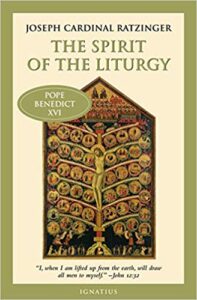
 If you’re looking for more information, check out The Spirit of the Liturgy by Pope Benedict XVI. With liturgy as his primary focus, the author touches on a number of issues closely related to the apocalyptic vision described by the author of the book of Revelation. Pope Benedict XVI’s discussion of the role of time and space in worship is especially pertinent. His thoughts about how Jesus draws all of time into eternity and the effect that
If you’re looking for more information, check out The Spirit of the Liturgy by Pope Benedict XVI. With liturgy as his primary focus, the author touches on a number of issues closely related to the apocalyptic vision described by the author of the book of Revelation. Pope Benedict XVI’s discussion of the role of time and space in worship is especially pertinent. His thoughts about how Jesus draws all of time into eternity and the effect that  this has on Christian worship is particularly helpful in understanding the treatment of time in the book of Revelation. You can read excerpts and learn more about The Spirit of the Liturgy and other works related to Bible study at ex libris—main bookshelf.
this has on Christian worship is particularly helpful in understanding the treatment of time in the book of Revelation. You can read excerpts and learn more about The Spirit of the Liturgy and other works related to Bible study at ex libris—main bookshelf.
the fourth Comforting Mystery of the Rosary
We’ve been taking note of sections of the book of Revelation that pair up with the Comforting Mysteries  of the Rosary, a set of Mysteries often used in private prayer by Catholics living in German-speaking countries. In this lesson we run into an obvious parallel with the fourth Comforting Mystery, “Jesus will judge the living and the dead.” Consider how Christians might find this idea comforting. What have you encountered so far in our study of The Revelation of Jesus Christ: The Faithful Witness
of the Rosary, a set of Mysteries often used in private prayer by Catholics living in German-speaking countries. In this lesson we run into an obvious parallel with the fourth Comforting Mystery, “Jesus will judge the living and the dead.” Consider how Christians might find this idea comforting. What have you encountered so far in our study of The Revelation of Jesus Christ: The Faithful Witness that you find comforting? You can learn more about the traditional Mysteries of the Rosary in Scripture & the Rosary: New Testament Mysteries, Old Testament Parallels. Free digital lessons from that Bible study are available on our website on a rotating basis throughout the liturgical year.
that you find comforting? You can learn more about the traditional Mysteries of the Rosary in Scripture & the Rosary: New Testament Mysteries, Old Testament Parallels. Free digital lessons from that Bible study are available on our website on a rotating basis throughout the liturgical year.
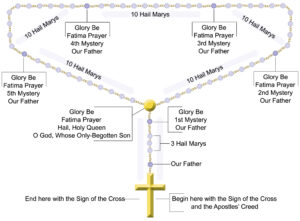 pray the traditional mysteries of the Rosary
pray the traditional mysteries of the Rosary
We invite you to pray the Rosary along with Turning to God’s Word co-founder Tami Palladino and her daughter Anne Marie. The prayers can be found at how to pray the Rosary, along with Tami and Anne Marie’s videos of each of the traditional Rosary Mysteries—the Joyful, Sorrowful, Glorious, and Luminous. Click on the diagram (right) to link to their how-to video. Visit the study directory of our most popular Catholic Bible study, Scripture & the Rosary: New Testament Mysteries, Old Testament Parallels, for more information about the Rosary and access to free online lessons.
the best Catholic commentary about Scripture
 To find out more about how Church teaching is supported by Scripture passages in The Revelation of Jesus Christ: The Faithful Witness, check out the Index of Citations in the Catechism of the Catholic Church. Links to the primary Scripture passages in the lesson (Revised Standard Version Catholic Edition [RSVCE*]) and relevant paragraphs in the Catechism are provided here. Not every passage in the biblical text for this Catholic Bible study is referenced in a Catechism paragraph, however.
To find out more about how Church teaching is supported by Scripture passages in The Revelation of Jesus Christ: The Faithful Witness, check out the Index of Citations in the Catechism of the Catholic Church. Links to the primary Scripture passages in the lesson (Revised Standard Version Catholic Edition [RSVCE*]) and relevant paragraphs in the Catechism are provided here. Not every passage in the biblical text for this Catholic Bible study is referenced in a Catechism paragraph, however.
the book of Revelation 20:7–10—paragraph 677
the book of Revelation 20:12—paragraph 677
ways our glossary might prove helpful
In addition to providing extra information about geographical locations, our glossary also points out persons and places mentioned in the biblical text under multiple names or spellings. If you can remember a name but aren’t sure in which lesson it shows up, you can find it in the glossary, which lists every proper noun in the primary biblical text for The Revelation of Jesus Christ: The Faithful Witness.
persons and places mentioned in the biblical text under multiple names or spellings. If you can remember a name but aren’t sure in which lesson it shows up, you can find it in the glossary, which lists every proper noun in the primary biblical text for The Revelation of Jesus Christ: The Faithful Witness.
to learn more, read more Scripture
If you’re having difficulty with a passage of Scripture, it can be helpful to read the  cross references pertaining to it—but looking these up can take time. To make that easier, we’ve compiled the cross references from the Revised Standard Version Second Catholic Edition (RSV2CE)—the translation that we reprint in our study books. That list can be found at the top of every online study page, and it includes links to cross references in the primary biblical text for The Revelation of Jesus Christ: The Faithful Witness.
cross references pertaining to it—but looking these up can take time. To make that easier, we’ve compiled the cross references from the Revised Standard Version Second Catholic Edition (RSV2CE)—the translation that we reprint in our study books. That list can be found at the top of every online study page, and it includes links to cross references in the primary biblical text for The Revelation of Jesus Christ: The Faithful Witness.
review previous lessons
As we progress through the book of Revelation, the images become more complex, increasing the potential for confusion. To help participants  in our study keep track of what’s happening in the Scripture, we’ve prepared a chapter-by-chapter review of key events and images in the book of Revelation. A link can be found at the top of every online study page that accompanies The Revelation of Jesus Christ: The Faithful Witness.
in our study keep track of what’s happening in the Scripture, we’ve prepared a chapter-by-chapter review of key events and images in the book of Revelation. A link can be found at the top of every online study page that accompanies The Revelation of Jesus Christ: The Faithful Witness.
don’t forget about our indexes & extra online material

 If you’re trying to locate information about a specific Scripture passage, you can look it up in the index at the back of the study book or sample lesson. If you want to find a particular commentary, you can look up its title in the topics index. To learn more about another book of the Bible for which there’s a Turning to God’s Word study, visit the online study directories to read the commentaries and watch any accompanying videos. Finally, if you have a question or would like to make a comment about any of our studies, you can use one of the “ask us your question” or “what do you think” buttons to email our authors.
If you’re trying to locate information about a specific Scripture passage, you can look it up in the index at the back of the study book or sample lesson. If you want to find a particular commentary, you can look up its title in the topics index. To learn more about another book of the Bible for which there’s a Turning to God’s Word study, visit the online study directories to read the commentaries and watch any accompanying videos. Finally, if you have a question or would like to make a comment about any of our studies, you can use one of the “ask us your question” or “what do you think” buttons to email our authors.
ex libris—Church documents & books about religious topics
You can find links to magisterial documents referred to in Turning to God’s Word Catholic Bible studies  at ex libris—magisterial documents. This page includes a listing of significant recent encyclicals as well as a number of historical Church documents. Recommended books related to Scripture study can be found at ex libris—main bookshelf.
at ex libris—magisterial documents. This page includes a listing of significant recent encyclicals as well as a number of historical Church documents. Recommended books related to Scripture study can be found at ex libris—main bookshelf.
wondering how to pronounce some of these words?
The following link is to a reading from the New International Version (NIV) Bible. To listen, click on the audio icon above the printed text. Although not taken from the translations used in our study materials, the NIV reading provides an audio guide to pronunciation of words in this lesson’s primary biblical text. A close online version of the translation of the Bible used in Catholic liturgy in the United States as well as an audio guide for daily Mass readings for the current month can be found on the website of the United States Conference of Catholic Bishops (USCCB).
the book of Revelation 20:1–15 (NIV)
 close with Bible-based prayer related to this lesson
close with Bible-based prayer related to this lesson
Many of our Catholic study groups like to conclude their discussions with a prayer based on the scriptural focus of their lesson, and some participants include Scripture-specific prayer in their individual study. If you’re uncomfortable composing your own Bible-based prayers, you can follow our four easy steps. If you prefer, you can use the following short prayer based on this lesson’s text from the book of Revelation.
All-knowing God, you understand everything that we do not.
Help us to grasp the proper significance of difficult images
in the book of Revelation in order that our study
of your Word may strengthen our faith
and renew our love and commitment to you.
We ask this in the name of your Son, Jesus Christ,
who never wavered in his love and commitment. Amen.
Lesson 22 I Saw a New Heaven & a New Earth, the book of Revelation 21:1–27
Lesson 20 The Mighty Voice of a Great Multitude, the book of Revelation 19:1–21
you also may like our study of Scripture & the Rosary
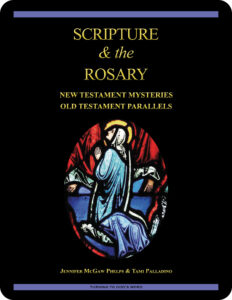 Scripture & the Rosary: New Testament Mysteries, Old Testament Parallels, a 26-lesson Catholic Bible study with an imprimatur, looks at the biblical foundations of the Rosary. The study includes lessons on Pope St. John Paul II’s Rosarium Virginis Mariae (Rosary of the Virgin Mary), the Apostles’ Creed, and the Luminous Mysteries as well as the original 15 Mysteries of the Rosary. Color photographs of stained glass windows depict key scenes in the lives of Jesus and Mary. Free digital lessons rotate throughout the year on our website.
Scripture & the Rosary: New Testament Mysteries, Old Testament Parallels, a 26-lesson Catholic Bible study with an imprimatur, looks at the biblical foundations of the Rosary. The study includes lessons on Pope St. John Paul II’s Rosarium Virginis Mariae (Rosary of the Virgin Mary), the Apostles’ Creed, and the Luminous Mysteries as well as the original 15 Mysteries of the Rosary. Color photographs of stained glass windows depict key scenes in the lives of Jesus and Mary. Free digital lessons rotate throughout the year on our website.
start a Turning to God’s Word Bible study
 Thank you for your interest in The Revelation of Jesus Christ: The Faithful Witness.
Thank you for your interest in The Revelation of Jesus Christ: The Faithful Witness.  Information about beginning a Turning to God’s Word Bible study can be found at start a Bible study. Tami, Matthew, and I are available to answer questions and offer support. Contact us if you’d like to start one of our studies or have your schedule listed with other TtGW study groups on our website. —Jennifer
Information about beginning a Turning to God’s Word Bible study can be found at start a Bible study. Tami, Matthew, and I are available to answer questions and offer support. Contact us if you’d like to start one of our studies or have your schedule listed with other TtGW study groups on our website. —Jennifer
*There are seven deuterocanonical books in the Old Testament—the Books of Tobit, Judith, Wisdom, Sirach, Baruch, and First and Second Maccabees, as well as some passages in the Books of Esther and Daniel. Protestants usually refer to these works as “apocryphal,” a word that means “outside the (Protestant) canon” because they’re excluded from most Protestant Bibles. The word “deuterocanonical” means “second canon”; Catholics use that word to refer to any section of the Catholic Old Testament for which there are no extant, or existing, Hebrew manuscripts. All of the deuterocanonical books appear in the Septuagint, the earliest remaining versions of which date to the 1st century B.C. This Greek translation of the Old Testament was in common use by Jews at the time of Jesus. Learn more by reading How Do Catholic & Protestant Bibles Differ?
Turning to God’s Word printed Bible studies use the 2006 Revised Standard Version Second Catholic Edition (RSV2CE) translation for all Scripture references except those to the Psalms, which are taken from The Abbey Psalms and Canticles, prepared by the Benedictine monks of Conception Abbey and published in 2020 by the United States Conference of Catholic Bishops (USCCB). All Scripture links for the online pages of The Revelation of Jesus Christ: The Faithful Witness are to the 1966 Revised Standard Version Catholic Edition (RSVCE) translation. The New International Version (NIV) audio recordings follow the same chapter and verse numbering as the RSV Catholic translations, but the NIV translation doesn’t include the deuterocanonical books and passages.
The 1966 RSVCE uses archaic pronouns and verb forms such as “thee,” “thou,” “didst” in the Psalms and in direct quotations attributed to God. The 2006 RSV2CE replaces these with more accessible English. The few significant translation changes in the RSV2CE include rendering almah as “virgin” in the Book of Isaiah 7:14 and restoring the term “begotten” in the Gospel According to John 3:16.
Numbering varies for some passages in this Bible study. Turning to God’s Word studies (print and digital) follow the numbering in the Revised Standard Version Catholic translations (RSV2CE and RSVCE). Discrepancies in the New American Bible Revised Edition (NABRE) are noted in the Index of Scripture Citations in the study book and the online sample.
 You can learn more about the Psalms by viewing a sample lesson from the Turning to God’s Word Catholic Bible study Sing a New Psalm: Communicating with God Through the Prayers of the Church—Volume I: Lauds & Vespers. The second part of that study, Sing a New Psalm: Communicating with God Through the Prayers of the Church—Volume II: Vigils, Day Prayer & Compline, is scheduled for publication in 2025. Some verse numbers may vary in different translations of the Psalms.
You can learn more about the Psalms by viewing a sample lesson from the Turning to God’s Word Catholic Bible study Sing a New Psalm: Communicating with God Through the Prayers of the Church—Volume I: Lauds & Vespers. The second part of that study, Sing a New Psalm: Communicating with God Through the Prayers of the Church—Volume II: Vigils, Day Prayer & Compline, is scheduled for publication in 2025. Some verse numbers may vary in different translations of the Psalms.
